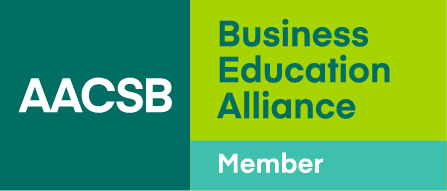Why All Business Schools Should Teach Storytelling
- Storytelling is a powerful strategic tool that people in all disciplines can use to build trust, inspire action, and cut through the “noise” of our era.
- When future business professionals learn the art of storytelling, they develop an essential communication skill that goes beyond traditional data-driven approaches.
- The University of Iowa’s Story Lab enables students to practice crafting and delivering compelling narratives as they enhance their leadership skills, professional networks, and interpersonal connections.
In today’s high tech, data-driven world, it’s easy to get lost in the constant flow of information. But companies that do the best job breaking through the noise aren’t necessarily the ones using the newest, trendiest technologies or pushing out the most content. Ironically, they’re often the ones that employ one of mankind’s oldest tools: storytelling.
In fact, sharing well-crafted stories remains one of the best ways for companies—and individuals—to stand out at a time when it’s harder than ever to do just that.
The Business Case for Storytelling
It’s easy to categorize storytelling as just another soft skill. But it’s so much more than that. Storytelling is a strategic tool for building trust, inspiring action, and driving results for business leaders, entrepreneurs, and job seekers.
Research shows that stories are seven times more likely to be remembered than facts and figures alone. Well-told stories tap into our emotions and create lasting impressions, making them far more effective than data or logic when it comes to influencing behavior.
Consider some of the most successful brands in the world. They don’t just sell products or services—they tell stories. LEGO, for example, doesn’t just sell plastic building blocks; it tells a story of imagination, creativity, and endless possibility that resonates with both children and adults. The company’s narratives celebrate the power of play, innovation, and human potential to build extraordinary things from simple components.
LEGO doesn’t just sell plastic building blocks; it tells a story of imagination, creativity, and endless possibility.
While storytelling seems like a natural fit for a company such as LEGO, the technique can be just as effective for companies in industries that might seem less driven by imagination. Moreover, this skill is useful across various business functions, including marketing, sales, entrepreneurship, and leadership.
For example, Thasunda Brown Duckett, CEO of TIAA, often engages in storytelling to show how leaders can use their personal stories to connect with people and inspire action. By sharing her own journey and experiences, she makes complex business ideas easier to understand and helps people relate to important company goals.
Integrating Storytelling Into the Curriculum
Employers consistently rank communication as a top job skill, according to a 2024 LinkedIn survey. But effective communication skills alone are not enough to make job candidates stand out. In an era defined by information overload, the ability to tell a story that resonates with audiences is more valuable than ever. As neuroscientist Antonio Damasio notes, “Story is the fundamental way in which the brain organizes information in a practical and memorable manner.”
Business schools can meet an essential need of the marketplace by integrating storytelling throughout their curricula. To start, business faculty can weave narrative techniques into existing courses such as marketing and leadership; or, they can create dedicated storytelling classes that teach students how to craft compelling narratives and engage audiences effectively.
Professors who want to think more outside the box can engage in collaborations across campus with writing and theater departments. By working with their colleagues in the humanities, business faculty can give students the tools and training to craft stories and opportunities to deliver them in front of a supportive audience.
Of course, rethinking traditional approaches to business school curricula presents significant hurdles. Some faculty might be skeptical about the value of allocating limited class time to teaching this skill, while others might be uncertain about how to develop meaningful assessment methods. But there are ways to ease the transition.
Creating a Story Lab
At the University of Iowa’s Tippie College of Business in Iowa City, we have taken a number of steps—both big and small—to give storytelling a greater focus in our curriculum. Along the way we have tried to make the changes as easy as possible for faculty.
For instance, we have offered faculty development workshops that demonstrate storytelling’s practical value and strategic importance in business communication. In addition, we have created supportive training programs, clear assessment rubrics, and a curriculum that seamlessly incorporates narrative techniques. In the process, we have transformed traditional teaching approaches in ways that better prepare our students for real-world leadership challenges.
A centerpiece of our approach is the Story Lab program, which leverages the university’s renowned writing tradition and helps students hone their storytelling skills to gain a strategic advantage in the business world. Students who complete this co-curricular program do not receive grades or course credit. We believe this noncredit format is essential. Public speaking is already a source of anxiety for most students—grading students as they engage in experiential learning related to this skill would only create unnecessary tension.
Each semester, this immersive, experiential program kicks off with a series of intensive workshops. The same four-hour workshop is offered four different times early in the semester, so that students can choose the time that works best for them. The target enrollment for the workshops is approximately 12 to 15 students, a class size big enough to provide engagement but intimate enough to foster one-on-one learning and peer mentorship.
During these workshops, students learn the basics of good storytelling. While many forms of communication can be classified as a story, this program focuses on personal narrative storytelling—true stories told out loud by the students in front of an audience.
Students are encouraged to include sensory details, brand names, and other elements of nostalgia to help their narratives stand out in the hearts and minds of the audience.
Students are encouraged to mine their lives for stories, looking for times when their routines were interrupted, when they made essential decisions, and even when they made mistakes. While this can be uncomfortable, students learn that sharing these moments of vulnerability often inspires connection and reciprocity in others, making the members of the audience more likely to share their own challenges. As Brown Duckett of TIAA puts it, “As a leader, if I show you my vulnerability, I create permission for you to show yours.”
The workshops also impart lessons that are grounded in story structure—how to get from point A to point B. Students learn that the best personal narratives involve some sort of transformation along a particular journey. For example, a student who talks about being socially awkward at a new school might end by describing how he or she overcame that social obstacle and found connection among new friends.
As the students begin practicing their stories, they learn to get from point A to point B through a series of richly drawn scenes, brief summaries, and omniscient reflections. Along the way, students are encouraged to include sensory details, brand names, and other elements of nostalgia to help their narratives stand out in the hearts and minds of the audience. They also learn to craft strong opening and closing moments to capture and maintain their audience’s attention from beginning to end.
Not only that, students receive valuable instruction and experience in public speaking and executive presence. When they develop both verbal and nonverbal communication skills, they will have a more solid foundation not only for telling better stories, but also for giving stronger in-class presentations, job interviews, and more.
In addition to guidance from the Story Lab director, who leads the workshops, students also receive support and coaching from peer mentors who have previously participated in the program. These coaching experiences are as valuable for peer mentors as they are for workshop participants. Mentors not only enhance their own storytelling skills, but also learn valuable leadership lessons, such as how to create a safe space for sharing personal stories and how to deliver feedback to others.
After the workshops, students are invited to refine their stories for an end-of-semester showcase, modeled after the live storytelling events held by The Moth. Each semester, students base their performances on a common theme determined by the program’s peer mentors. Past themes have included the future, challenges, beginnings, and growth.
The showcase is held at a local co-working space with an audience whose members range from faculty and staff to family and friends to individuals from the local business community. The event is professionally recorded to allow students to share their performances with online audiences. That way, they can have an even broader impact. Below are three of the stories that our students crafted for the fall 2024 event:
Reaching Every Student With Story
Story Lab was developed by the college’s leadership center, which views storytelling as a foundational tool in leadership. “It’s really important for leaders to gain the credibility of those that they’re leading. Storytelling is a way for people to gain that,” says Stephen Courtright, a research professor and executive director of the Tippie Leadership Collaborative. “It’s a real advantage for our students.”
For example, Courtright has heard from several students who said that Story Lab has enabled them to expand their networks and make deeper connections with people, “because they’ve each told their stories.”
One such student is Afley Barnabus, who is originally from Tigray, a region in northern Ethiopia. “Where I come from,” Barnabus said, “people rarely use spoken English and their stories are usually suppressed. Story Lab was an opportunity not only to improve my speaking skills but also to tell stories of the struggles faced by me and many others.”
Story-framing allows students to interpret their entrepreneurial ventures as a hero’s journey, in which they must tackle problems and ultimately deliver transformative solutions.
Each semester, approximately 50 members of the campus community take part in our in-person Story Lab workshops, and about 20 individuals take part in an online version offered through our MBA program. We have considered growing the program to get every student involved, but we ultimately decided that doing so would strain resources and potentially diminish the highly personalized student experience.
Instead, we added a unique event to the college’s required business communication course. Each semester, all 800 students enrolled in this class are required to attend “Story at Work,” which features a storytelling expert from industry and offers a highly concentrated dose of instructional content on how storytelling for business works. In the 2024–25 academic year, the event featured Miri Rodriguez, Senior Storyteller at Microsoft.
Within this format, students receive insights into careers in story and can ask the speaker questions. We also make sure that students leave the event with a suggested activity that requires them to integrate story into their work and lives.
Impact Across Campus and Community
Story is deeply integrated into other disciplines within Tippie’s business curricula as well. For example, students in the John Pappajohn Entrepreneurial Center participate in Story Lab sessions where they learn Tippie’s story-framing approach. Story-framing allows students to interpret their entrepreneurial ventures as a hero’s journey, in which they must tackle problems and ultimately deliver transformative solutions.
In addition to learning story-framing for pitches, students enrolled in Tippie’s Risk Management and Insurance program are encouraged to apply storytelling to their efforts to build their networks and strengthen their personal connections. They learn how this skill can help them stand out in a world where graduates’ résumés and LinkedIn profiles can look surprisingly similar.
Tippie’s Story Lab also has an impact across campus and in the community at large. Story-focused programming has been sought after by other entities on campus, including the departments of healthcare, pharmacy, engineering, and athletics, as well as the Greater Iowa City Community Leadership Program.
More importantly, we are hearing from students that by embedding storytelling throughout our curriculum, we are helping them develop greater confidence in their communication skills, gain a deeper understanding of leadership principles, and enhance their ability to connect with audiences on an emotional level. “I think my stories can motivate people to get to where they want to be,” said Story Lab participant and peer mentor Amelia Szczerba. “My stories also show who I am and why I think the way I do.”
There is no doubt that leaders who want to drive meaningful change need to be able to articulate a compelling vision and inspire others to follow them. By teaching storytelling to business school students, we empower them to become more effective communicators, persuasive leaders, and innovative thinkers.
In other words, in a world where attention is a scarce commodity, storytelling is key to helping the next generation of leaders cut through the noise and make a lasting impact.






